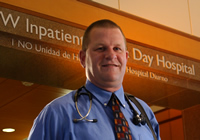Last updated: July 31, 2012
NHGRI Researcher Wins ASGCT Outstanding New Investigator Award
NHGRI Researcher Wins ASGCT Outstanding New Investigator Award
The award is one of four that will be given to new investigators at the society's 13th annual meeting, along with other awards for outstanding achievement and excellence in the field. According to the award announcement, the new investigator award is based on Dr. Venditti's many contributions to the field of gene and cell therapy. The award includes an invitation for Dr. Venditti to present a symposium talk during the annual meeting.
"This award is a deserving recognition of the highly innovative and promising research Charles Venditti is conducting as an NHGRI investigator," said NHGRI Director Eric D. Green, M.D., Ph.D. "The terrific thing about a new investigator award is that I have no doubt that there is much more to come from the efforts Chuck has begun and which already have earned this national recognition from the American Society for Gene & Cell Therapy."
Dr. Venditti studies a group of inherited metabolic disorders that cause methylmalonic acid and homocysteine to accumulate in body fluids until they reach toxic levels. Methylmalonic acid is produced when proteins are broken down in the cells of the body, but if levels reach toxic levels, it can cause methylmalonic acidemia (MMA), which is associated with multiple disorders, including the failure of babies to thrive, severe metabolic instability, seizures and strokes, developmental delays, pancreatitis and kidney disease. Homocysteine is an amino acid by-product of cell metabolism that, when it reaches toxic levels in the blood, causes an increased risk of coronary heart disease, stroke and peripheral vascular disease.
The disorders are generally caused by impaired intracellular metabolism of vitamin B12 or by defects in two enzymes that require the vitamin to function. Dr. Venditti and his colleagues conduct clinical research aimed at defining the natural history of these conditions, as well as laboratory studies that use metabolic, genetic and genomic approaches to better-understand the basic biology underlying these disorders.
"The conditions are prototypical of a larger group of disorders collectively called the organic acidemias," Dr. Venditti said, adding that the metabolic disorders are very difficult to treat and patients have multi-systemic disease. "Our clinical studies led to the appreciation that solid organ transplantation can be a highly effective way to treat some of the patients, and have encouraged the pursuit of gene therapy experiments in cells and mice."
Early phases of Dr. Venditti's work explored the complex pathophysiology that is associated with MMA using mouse models his group created. He also studies tissues that were donated by affected patients in the clinical research study.
"In our first gene therapy experiments, we were able to demonstrate a high efficacy of a gene therapy to restore enzyme function in MMA cells in the laboratory," Dr. Venditti said. "Those cells had been extracted from the liver of a study patient who was undergoing elective liver transplantation. We were able to use the diseased liver cells from the MMA patient and show they could be completely corrected using a gene therapy virus, even though they had severely damaged mitochondria." Mitochondria are structures inside cells that generate energy. Further studies using MMA mice provided preliminary evidence that gene therapy might hold promise as a possible treatment for MMA if persistent expression and metabolite independent monitoring could be developed.
Recently, Dr. Venditti and Randy Chandler M.S., a doctoral student in the laboratory, have tested a new gene therapy strategy in MMA mice that they developed using adeno-associated virus to carry the repair gene into the defective cells. The strategy turns out to be highly effective.
In parallel, the research team has developed a new technique that uses stable radioactive isotopes to non-invasively track the activity of the introduced gene on the breath of treated subjects — in this case mice. The team hopes to soon test the approach on human patients. The method relies on the ability to track heavy carbon as it is metabolized, and the approach is the subject of a patent Dr. Venditti has filed for an invention that is described in the most recent mouse gene therapy studies.
Dr. Venditti is pleased with the attention that the ASGCT award draws to the laboratory and the diseases he studies. "I am most grateful that our work has been recognized by the ASGCT," he said. "The award has served to highlight the potential that methylmalonic acidemia, and by extension, other organic acidemias, will emerge as fruitful candidate disorders for the application of gene and cellular therapies. I believe such therapies offer hope to the many families and patients who struggle to live a normal life, and that someday we will have better treatments for MMA."
The ASGCT is a professional non-profit medical and scientific organization dedicated to the understanding, development and application of genetic and cellular therapies, and the promotion of professional and public education in the field. The society includes researchers, clinicians and other professionals from around the world dedicated to discovering and developing new genetic and cellular therapies.

